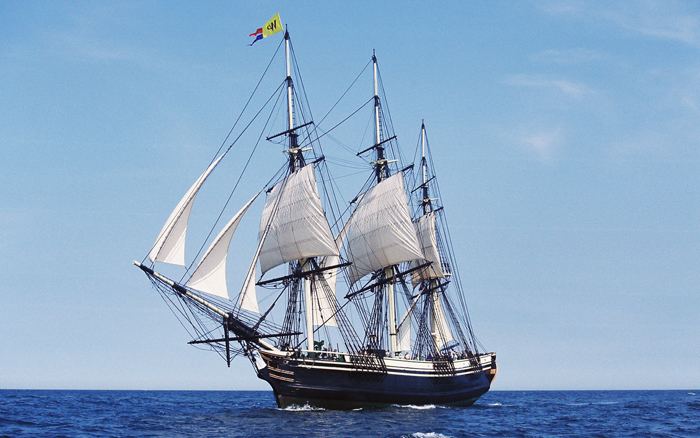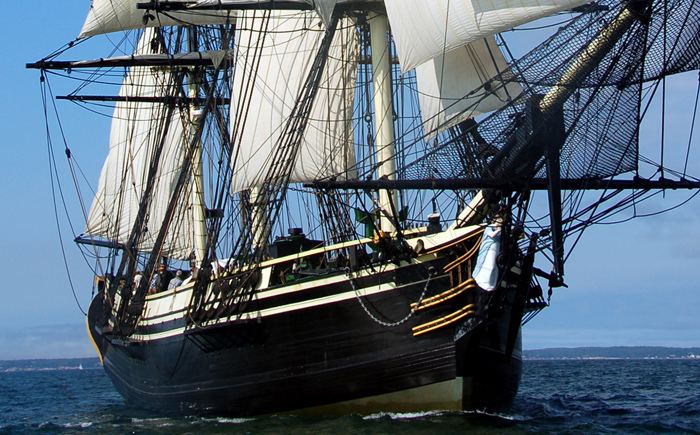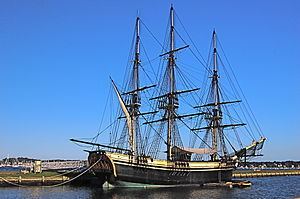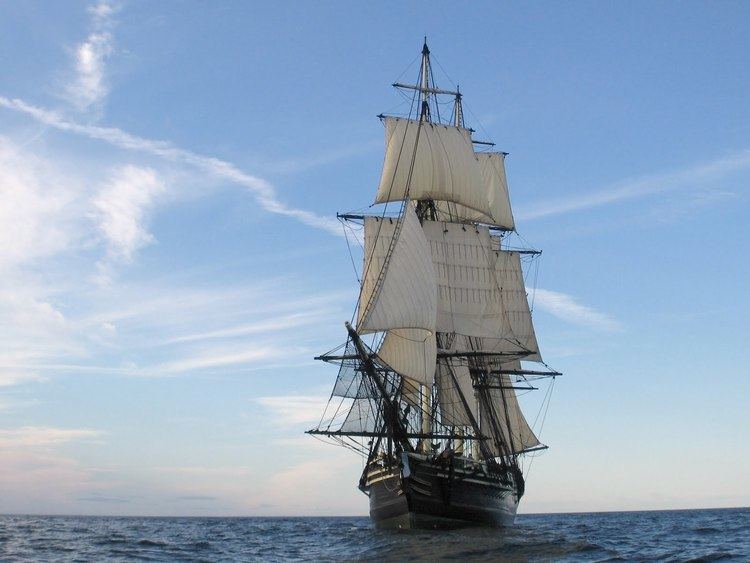Name Friendship of Salem Acquired September 1, 1998 Status in service Builder Scarano Brothers Shipyard | Namesake Friendship (1797) Homeport Salem, MA Launched November 1996 | |
 | ||
Badge Woman in classical dress offering a bouqet of flowers | ||
Friendship of salem the east indiaman of salem
The Friendship of Salem is a 171-foot replica of a 1797 East Indiaman. It was built in 2000 in the Scarano Brothers Shipyard in Albany, New York. The ship usually operates as a stationary museum ship during most of the year. But it is a fully functioning United States Coast Guard-certified vessel capable of passenger and crew voyages; it makes special sailings during various times of the year. The Friendship of Salem is docked at the Salem Maritime National Historic Site, established in 1938 as the first such site in the United States. The site, which includes several structures, artifacts and records, is operated by the National Park Service.
Contents
- Friendship of salem the east indiaman of salem
- The friendship of salem
- Construction
- Operation
- Friendship 1797
- Friendship 1830s
- References

The friendship of salem
Construction

The replica of Friendship was commissioned by the National Park Service as The Friendship of Salem. It was built using modern materials and construction methods, while retaining the appearance of the original 18th-century ship. The hull is cold molded with laminated wood and epoxy. The replica's design is based on a model in the collections of the Peabody Essex Museum. The model was built by Thomas Russell, the Friendship's second mate, and Mr. Odell, the Friendship's carpenter, as a gift for Captain William Story's infant son. Russell and Odell made the model during a voyage to China and Sumatra from June 1802 to August 1804. The replica's color scheme was taken from an 1805 painting of the ship by marine artist, George Ropes.
Operation

The ship is operated by a volunteer crew under supervision of the National Park Service. The Friendship of Salem sails as an ambassador ship for the Essex National Heritage Area.
Friendship (1797)

The original Friendship was built in Salem, Massachusetts by Enos Briggs's shipyard at Stage Point on the South River for owners Aaron Waite and Jerathmiel Pierce. The Friendship was launched 28 May 1797. It weighed 342 tons and was registered at the customs house on August 18, 1797. The Friendship was 102 feet long and 27 feet 7 inches wide. She regularly recorded speeds of 10 knots and was known to have logged a top speed of 12 knots. The Friendship made fifteen voyages during her career and visited Batavia, India, China, South America, the Caribbean, England, Germany, the Mediterranean and Russia.

The Friendship cleared Salem for Canton in August 1797 on her first voyage under the command of Captain Israel Williams, but changed her destination to Batavia in the Dutch East Indies. Captain Williams had a keen interest in science and was a member of the East India Marine Society. When the ship's supply of water gave out at 22°50′S 21°46′W, he improvised a way to distill water.
On her third voyage the Friendship was commissioned as letter of marque, an armed trading vessels authorized by congress to seize enemy ships as prizes of war. Although letters of marques were similar to privateers, their primary function was trade so they carried smaller crews. During its career as a letter of marque the Friendship carried thirty men and fourteen guns to fend off French privateers.
Captain William Story of Marblehead served as master of the Friendship from 1801 to 1804. Before he assumed command of the Friendship Story had served as her first officer on her first five voyages. Under his command the Friendship made voyages to Russia, Spain, Italy, China, Sumatra, and Batavia. The Friendship's voyage to Canton, China in 1803 was an exceptionally profitable one. While Story was in China with the Friendship in 1804, the artist Spoilum painted his picture.
After the Embargo Act went into effect on December 22, 1807, the "Friendship" returned to Salem from the Mediterranean and did not leave port until it was lifted on March 1, 1809. For two years she sat at the wharf failing to generate any profits for Waite and Pierce. Having sat at the wharf for extended period of time the Friendship was in poor condition when Israel Williams set out for Gotenburg, Sweden. He barely made it to Cape Cod when he was forced to turn back to Salem because the Friendship was Leaking. After she was repaired the Friendship made three voyages to Archangel Russia under Captain John Brookhouse and Captain Edward Stanley. Unfortunately for Stanley, she was captured as a prize of war by HMS Rosamond on September 5, 1812. Stanley did not know that the United States and Great Britain were at War. The Friendship was condemned as a prize of war in the High Court of Admiralty in London on December 7, 1812. Afterwards her fate is unknown because she disappears from the records. A full rigged model of the original Friendship was donated to the Peabody Academy of Science.
Friendship (1830s)
In 1815, Jerathmiel Pierce and Aaron Waite had a second ship with the same name constructed at Portland, Maine. This new Friendship weighed 366 tons and was registered at the customs house in Salem on January 6 of the following year. Three years later she was sold to George Nichols, Ichabod Nichols, Benjamin Pierce, Henry Pierce and Charles Saunders. In 1827 the vessel was purchased by Dudley L. Pickman, Nathaniel Silsbee, William Zachariah Silsbee and Richard F. Stone who employed the vessel in the pepper trade.
Charles Moses Endicott, master, anchored off the Sumatra town of Quallah Battoo in 1831. While Endicott and other officers were ashore engaged in the pepper trade, the first mate ignored the safety precautions the captain had instituted such as limiting the number of Malays allowed on board while loading pepper. Once Malay pirates had the crew distracted, they captured the ship, murdered some of the crew, and looted the cargo. Captain Endicott and the other officers on shore tried to return to the Friendship and render aid to the crew unsuccessfully, but were prevented by the superior number of Malay pirates. Next, they made their way to a nearby roadstead where the American vessels James Monroe, Palmer and Governor Endicott were lying at anchor. Once the captains of these vessels heard Endicott's story they hauled anchor and set sail to recover the Friendship.
They had hoped to pull alongside the Friendship with the James Monroe and board, but the rescue party was forced to abandon their original plan and board the Friendship with small boats instead when they learned she was inside a dangerous shoal. Captain Endicott returned to Salem July 16, 1831.
Three days after the Friendship arrived in Salem her owners wrote President Andrew Jackson and demanded he take action against the Malay pirates at Quallah Battoo. Jackson dispatched the frigate USS Potomac under commodore John Downes to punish the pirates. US Navy Commodore John Downes departed New York with the frigate Potomac, her Bluejackets and Marines on the First Sumatran Expedition, to avenge the attack on Friendship – which also helped launch the diplomatic career of New Hampshire merchant Edmund Roberts.
The previous service and ultimate fate of this Friendship is unknown, but she is reported as having belonged to Joseph Peabody, a Salem merchant and shipowner who dominated trade between Massachusetts and the Far East for a number of years.
